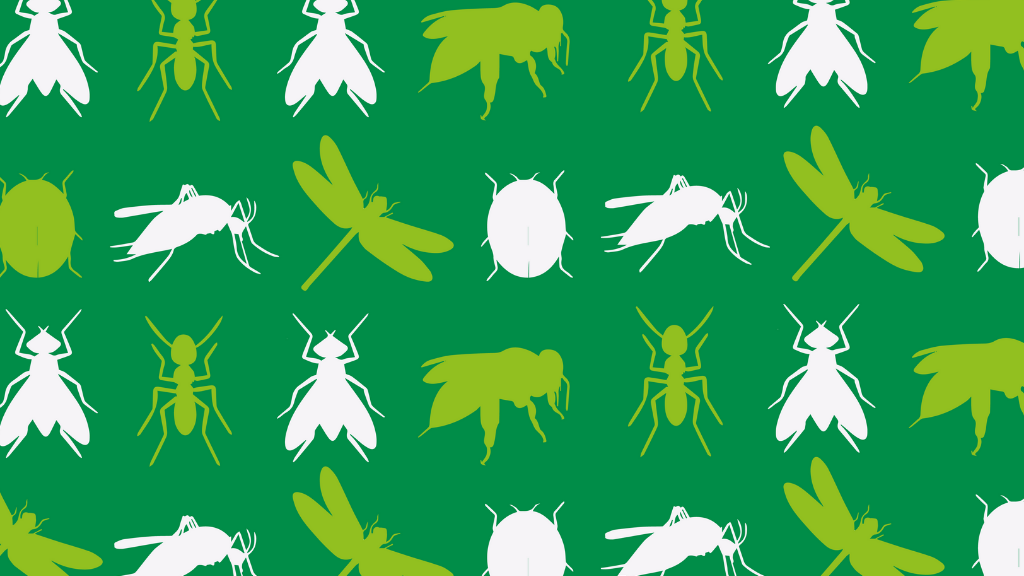Professor Stuart Reynolds is Emeritus Professor of Biology in the Department of Biology and Biochemistry at the University of Bath, and former President of the Royal Entomological Society.
What if there were no more insects? Recent media headlines all over the world have raised this question, often using apocalyptic terms. Remarkably, on 20 March 2019, the UK Parliament even took a few minutes off discussing Brexit to take note of the issue. Is all this entomological fuss justified?
The answer is yes. Scientific studies in the UK, Germany and now Central America clearly indicate that, in recent years, there has been a steady and widespread downward trend in insect numbers. The extent of these insect declines is not yet exactly measured, but it seems to be large. A paper from the UK reported that the catch of larger moths in a network of around 200 traps operated at sites all over Great Britain, showed a decline of 31% during the 35-year period up to 2002. Another one from Germany found the weight of insects flying into traps, operating at a large number of nature reserves, declined by more than 75% during the 27-year period 1989-2016. Another UK study in wheat fields, Sussex, found a 35% reduction in total arthropod numbers during the 42 years up to 2011. The well-marked decline of UK pollinators that has received so much attention in recent years continues to cause concern; although a few species are apparently increasing, fully one third of species are declining.
Never mind which of these exact figures is “correct”. None of these studies were originally designed to detect long term declines of this kind, and perhaps if they had been, then we might now have more accurate estimates. However the implication of studies like this is clear: there is a problem. Something is happening to the landscape in which we live that is unfriendly to our six-legged friends.
Putting aside the thoughts that immediately come to mind when thinking of a world without insects - no more mosquitoes, biting flies, stinging wasps, bedbugs, etc. (even these creatures have their place in the grand scheme of things) - it is pretty obvious that without insects, there would be big ecological problems. Insects are key components of essentially all land-based and freshwater food webs. Put simply, their role in the economy of nature is to eat and be eaten.
What is the economy of nature?
Think of it this way: the sun shines and its energy is captured by growing plants which then use it to convert carbon dioxide from the air into more plant material, fixing about 426 grams of carbon per square meter per year on average, over the Earth’s surface. Some of this new organic material is simply accumulated as plant growth, but approximately 10% is quickly consumed by a variety of herbivorous animals, most of which are insects or other invertebrates. Some of the plants (trees and bushes) get bigger from year to year, but most of them die down after each growing season. Even when plants die and decay, turning into the materials of fungi and bacteria, there are yet more insects that eat them.
But not all of the little animals eat growing or decaying plants; some of them eat each other. Going up the food chain, there are progressively fewer animals at each level because the conversion of material from one stage to the next is not 100% efficient, and there is less and less material left to construct these bigger animals. This is why, as ecologist Paul Colinvaux says, big fierce animals are rare.
This flow of energy and matter through ecosystems explains the structure of the natural world. We are accustomed to this without thinking about it. We expect there to be lots of plants, rather less material in the many little creatures and not many of the bigger ones. It’s also obvious to most people that when the little creatures at the base of the system experience problems, everything higher up in the food web will also be in trouble. It’s no accident that recent declines in the numbers of insects have been accompanied by parallel declines in numbers of insect-eating animals - frogs, lizards, some mammals, and some birds.
Once you start to think of it in these terms, it’s all really rather obvious what is happening to cause the insect declines of the headlines. Lots of people have gone on the record as blaming a particular pesticide, or agricultural practice (hedge-cutting at the wrong time of year, say, or too much oil-seed rape and not enough orchards), but actually, insect declines are the inevitable result of how we feed ourselves.
Farming - can we take it all?
For the last 10,000 years or so we humans have been using technology to make our own environment-modifying activities more efficient. Growing food is one of those activities. With a relentlessly increasing human population on the planet, we need to grow more and more food. And with increasing wealth, we collectively desire to consume foods (animal flesh for example) that are more costly to produce in terms of the land that is required to grow it. Because they aren’t making it any more, land is an increasingly scarce resource, and the aim of modern intensive farming is to produce as much food as possible on a given area. To maximise the farmer’s income, he or she aims to maximise the amount of the sun’s energy that is converted into the crop. Allowing plants that are destined to be eaten by people to be consumed instead by pest insects would obviously be wasteful, so steps are taken to make sure that there are no pest insects. The sprays that kill them off effectively concentrate more of the land’s production into human food. Similarly, to allow sunlight to be captured by plants that we don’t eat (“weeds”) would be wasteful; this waste is avoided by making sure that these undesirable plants do not grow. In turn that means that the insects that would have fed on some of those weeds are incidentally eliminated. It’s a tiny and almost unseen tragedy that some of those insects if left alone would have actually done the job of keeping down the weeds.
In effect, we humans are each year progressively capturing a greater share of the sun’s energy, much more than we used to do before the introduction of intensive farming. As farming gets more and more efficient, then the proportion of material that we take out of the system gets greater and greater. The extent of this human capture of newly fixed carbon is remarkable.
A paper in 2006 estimated that almost one quarter of the potential global land-based primary productivity (by which we mean plant growth) was appropriated by man, who turned it into crop and timber harvests and prevented the growth of natural vegetation. In much of the farmland of Europe, the Indian subcontinent, China and mid-East North America the extent of such appropriation was in the range of 40 – 80% of natural productivity.
When we take so much, it isn’t surprising that there’s not much left for nature. As we embrace efficiency in farming, less and less resources are available to support our six-legged friends. Farmers are not to be blamed for this; this is just the application to farming with steadily increasing success of an everyday economic system that we are familiar with in every walk of life. We are all responsible for it.
So what is to be done?
One recommendation is to leave a proportion of the planet’s resources for the use of wild nature. Humans can’t completely withdraw from farming to protect the insects however we can resolve to set a limit to our exploitation of the earth’s productivity.
Previous conservation policies and actions have too often been directed to particular ends; protecting this creature, or that creature, this environment and not that one. But it’s so easy to get it wrong when focusing on particular details (and natural ecosystems are awash with detail). Instead, we could simply decide to leave a certain proportion of the sun’s energy to fuel the natural world, and to hold back from “improving” farming so much that there is nothing left for nature. We should not thoughtlessly take it all, and then wonder where all animals, birds and bees went.
Bringing back the set-aside policy
The “set aside” policy was previously used in Europe to try and regulate agricultural production. From 1988 – 1996, the Common Agricultural Policy (CAP) of the European Community required large farmers to set aside 15% of arable land, which was later reduced to 10%. Small farmers could do this voluntarily, and both large and small farms received financial compensation for the reduced crop yield on their land. The policy endured until 2006.
Although the policy was politically inspired, largely to do with regulating food, mountains, wine lakes etc., set aside was shown both to improve the condition of the soil and biodiversity. In the early 2000's however, the scheme was scrapped in order to move to a system of fixed payments per hectare of land (the “Single Farm Payment”) that was much easier to administer. Conservation and social benefits were supposed to be secured through the “Second Pillar” payments scheme of the CAP, in which specified non-production-based goals were supported, but in recent years, this dual system has become unpopular with just about everyone, except big farmers. Arguably, it doesn’t work very well from the conservation and social point of view either. It will take many years of research to be sure whether the recent declines of insect life have anything to do with scrapping set aside, but the cancellation of set aside policy and insect decline can certainly be interpreted as more than coincidental.
But how much arable land should we set aside? A collective decision of 10%, or 20% overall perhaps? Such a target would be quite modest. E.O. Wilson, perhaps the planet’s most famous living biologist, has called for 50% of global land area to be set aside for nature. Against the gains that would accrue to farmland biodiversity we would have to set the reductions in food production. But persuasive studies have pointed out that reducing animal production by only a fraction, on the back of reduced meat consumption would not only improve human health through a better diet but would also release large amounts of land.
Set aside will be costly of course, and both the costs and benefits will depend on exactly where we choose to refrain from cultivating. To some extent, we can attribute economic value to insects and other denizens of wild nature and determine how these creatures provide “ecosystem services” that are worth a certain sum of money per year, incorporating the fact that insects are needed to pollinate our crops, to recycle waste resources, to stir up the soil. And scientists can help society attribute value to these things.
However, we need to go beyond looking at just its monetary value, and recognise that people feel better when they inhabit the same world as fleas, flukes and cuckoos; when they hear the birds sing at dawn, see dragonflies hawking along the riverbank; and even (indeed) when their bedrooms are invaded by hibernating ladybirds and their car windscreens are plastered with squashed flies. People will vote for this, as a world with no bugs would be a very dull place. We rely on them to run the economy of nature, and we cannot do it without them.
Responses





Very sad to see state of the world at this time.
It's always thought provoking when reading any article regarding climate change or environmental degradation that one can always find a way to a common factor: overpopulation.
In my view this tends to be the root cause of almost every problem we are currently facing but remains to be the elephant in the room. Something must be done but the question is who will do it? It's one thing to ask people to turn the lights off when they leave a room, let alone eat less meat and worse still to have less children.
However, if social policy won't tackle the issue, nature will soon step in - and it's means will be far less hospitable.